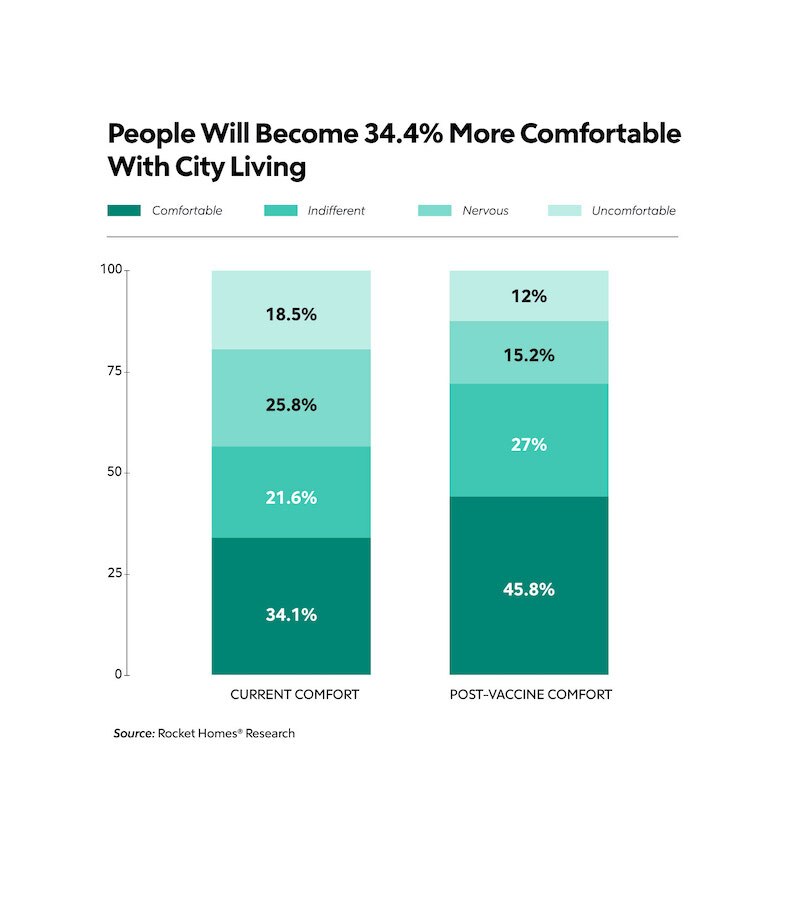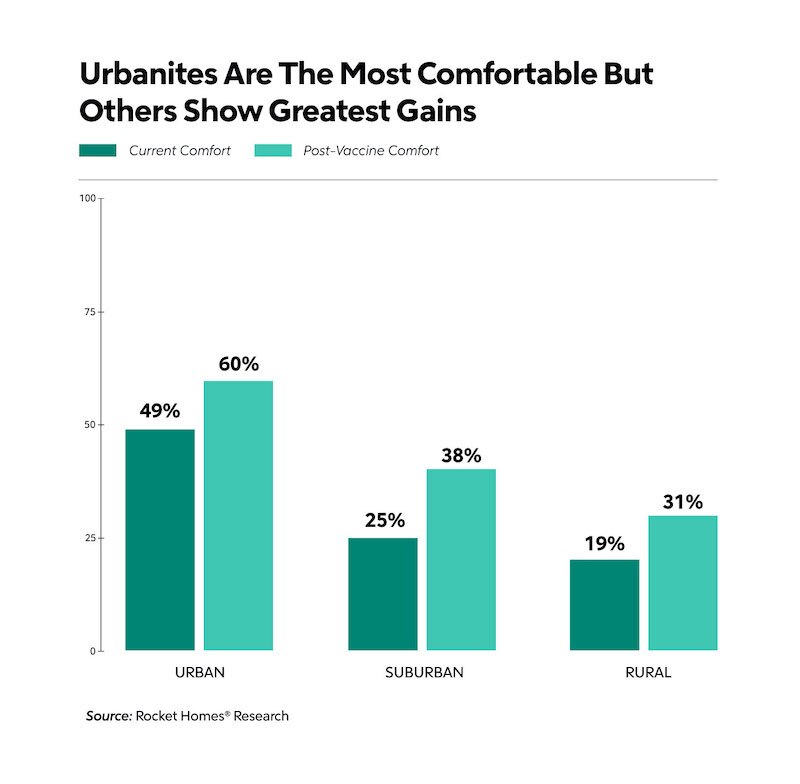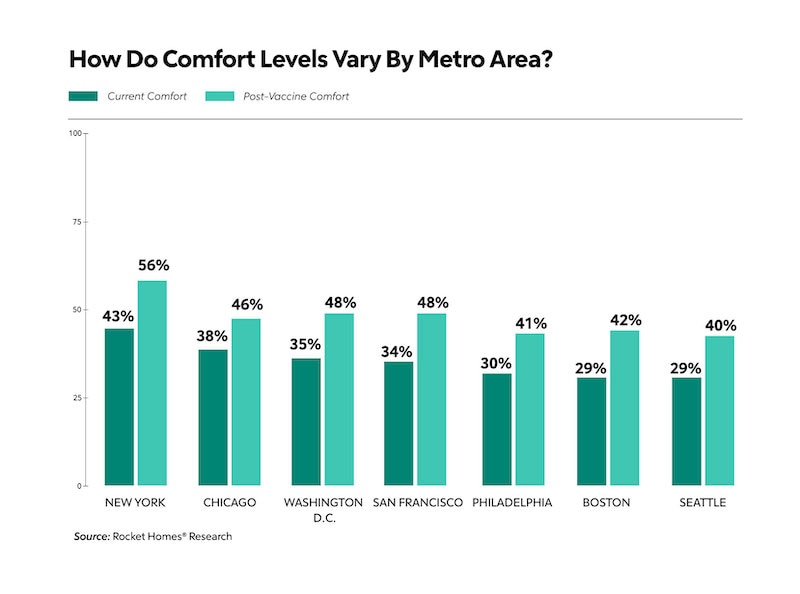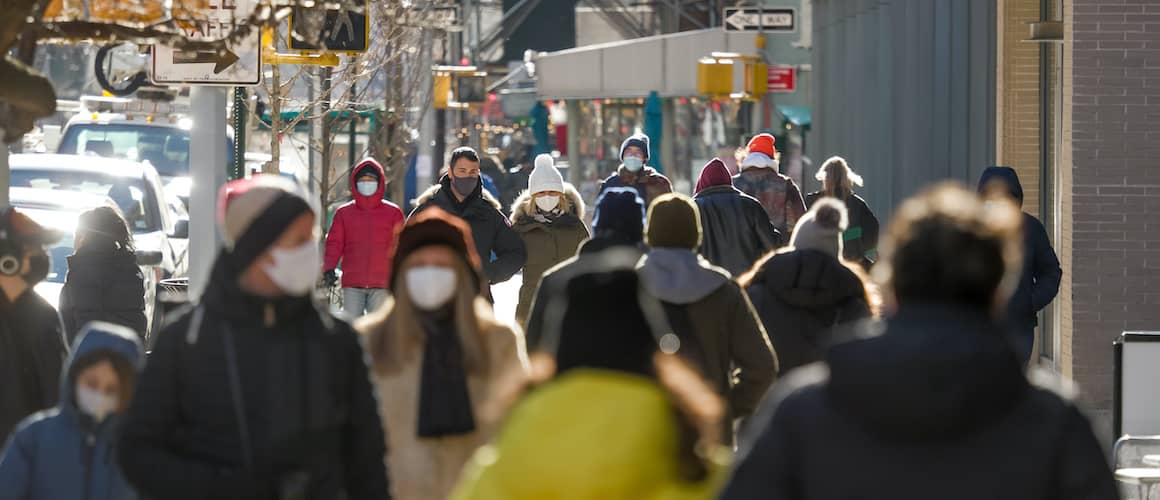- The amount of people comfortable living in large cities is expected to increase to nearly 1 in 2 once a vaccine is widely distributed, an increase of 34%.
- Comfort levels for those living in non-urban environments are expected to be impacted the most by the vaccine, rising by 50.2% for suburbanites and 63.2% for ruralites.
- Of the 7 metros surveyed, New Yorkers displayed the most resilience, having the largest population that reported being comfortable currently (42.6%) and post-vaccine (55.6%).
It’s no secret that cities have suffered since COVID-19 began spreading across the country. The pandemic has caused people to fear densely packed environments and rethink urban living as a result. At the same time, theaters and sports arenas have been unable to open, restaurants have been forced out of business and major corporations have sent their employees home to work remotely. Everything that furnishes cities with their vibrancy has all but disappeared due to COVID-19. Yet, while they are currently gone, they have not been forgotten.
However, after seeing more moving trucks invade the streets of some of America’s largest metros, media outlets began reporting that cities wouldn’t survive COVID-19. While dramatic headlines asserting that cities are dying have received quite a bit of attention, the mass exodus they’ve described has been greatly blown out of proportion. Some people may be leaving cities to spend the pandemic in larger, often more affordable living quarters – be it in the suburbs or vacation areas – but certainly not all.
A recent study conducted by Rocket Homes® surveyed thousands of Americans living in 7 major metro areas to determine what the future may hold for cities. The findings indicate that while COVID-19 may have caused people to question the current safety of U.S. cities, mass distribution of the vaccine will be the antidote that both our citizens and our urban landscapes desperately require.
Vaccine Distribution Is Increasing Confidence In Urban Living

The increasingly popular narrative suggests that COVID-19 has so shaken residents’ confidence in urban living that cities are dying out. With the dense populations, high cost of living and temporary closures of the best cities have to offer, it’s no wonder that some urban dwellers have chosen to take a hiatus from city life.
However, there hasn’t been any clear evidence that suggests they won’t bounce back once a vaccine is easily obtainable and herd immunity is achieved. In fact, the Rocket Homes® survey of residents from the Boston, New York City, Philadelphia, Washington D.C., Chicago, San Francisco and Seattle metro areas suggests that confidence in cities is growing thanks to the increasing availability of the COVID-19 vaccine.
According to the data, 1 in 3 people (34.1%) are currently comfortable living in a large city. However, once a vaccine is widely distributed, the population of comfortable individuals grows to 45.8%. These findings indicate that people will become 34.4% more comfortable with city living in a post-vaccine world.
Meanwhile, individuals who stated they would be nervous about living in a city decreased from 25.8% to 15.2%. Therefore, it seems that anxiety over urban living will ultimately drop by 41.1%.
Suburban And Rural Communities May Be Key To In-Migration Issues
Individuals’ current living environments played a significant role in their confidence in the safety of city living. Unsurprisingly, those who already live in an urban environment demonstrated the highest levels of comfort both during the pandemic and post-vaccine. Nearly half (49.2%) of urbanites said they are currently comfortable, while 59.6% said they will be after the vaccine is readily available, marking an increase of 10.4%.

Although people living in suburban and rural environments did not show nearly as much confidence as urbanities, they did demonstrate considerable gains. Suburbanites are expected to become 50.2% and ruralites 63.2% more comfortable with city living once the COVID-19 vaccine is widely distributed. This growth in confidence for non-urban dwellers may suggest even greater hope for the future of large cities.
According to a recent study conducted by the Federal Reserve Bank of Cleveland, the true impact of the pandemic on American cities was not the out-migration of urban dwellers but instead the hundreds of thousands of people who refrained from moving into cities last year. If in-migration was the actual problem, the significant increase in comfort illustrated by suburban and rural residents could indicate that U.S. cities will, in fact, rebound with the widespread distribution of the vaccine.
Urban Confidence Fluctuates By Metro Area

As the epicenter of the country’s first wave of the pandemic, New York City has been the primary focus of negative press, with countless news sources questioning whether the City that Never Sleeps has finally been put to rest. Yet, the New Yorkers surveyed displayed the most resilience, having the largest population that reported being comfortable currently (42.6%) and post-vaccine (55.6%).
On the other side of the country, Seattleites demonstrated the most reluctance regarding city living. Only 29% of Seattle’s residents reported feeling comfortable living in a large city now. Post-distribution comfort levels were not much better, as the percent of Seattle residents who said they would feel comfortable living in a city merely rose to 40.3%.
Back on the East Coast, Boston showed the greatest growth in comfort. Although Bostonians had lower levels of confidence in city living, their reported comfort level increased by 44.1% when the vaccine was mentioned. By contrast, Chicagoans illustrated the lowest gains. Comfort in urban living increased by just 22.4% for residents of the Chicago metro area.
Those Who Enjoyed City Living Once Are Bound To Return
Past experience with urban living is a major indicator of people’s comfort living in a large city. When you isolate individuals who had a positive experience, there’s a considerable jump in the numbers.

Two out of 3 people (66%) who characterized their experience as “the best time of my life” said they would be comfortable living in a city right now. That number grows to 4 out of 5 people (79%) when the vaccine is taken into consideration.
What’s more, 72.4% of current suburban residents who classified their previous experience living in a city as extremely positive say they’d be comfortable moving back into a city once the vaccine is widely distributed. This data further indicates that cities are likely to rebound because city enthusiasts are bound to return once dense environments are deemed safe again.
People Are Still Drawn To Cities For The Same Reasons
While the restaurant industry has taken a severe beating as a result of the pandemic – with restaurants being forced to close their doors and their employees having to file for unemployment – individuals seem to have faith in their ultimate endurance.
When it comes to what makes them interested in living in a large city, 50% of respondents pinpointed restaurants. Although many restaurants have not survived, there’s an apparent belief that a host of new eateries will start to open and provide cities with the same magnetism they had before COVID-19.
And, though many have predicted that the new wave of remote work will ultimately cause commercial districts to shutter and urban talent pools to drain, job opportunities still ranked as #2 on the list of what continues to draw people to cities. For 46% of participants, work would still motivate them to live in one of the country’s major cities.
Cities’ Drawbacks Haven’t Changed Either
When asked what made them uninterested in living in a large city, high cost of living was the top reason selected. For 57% of individuals, it’s the exorbitant prices that make them question city living.
Interestingly, germs fell toward the bottom of the list, having been chosen by only 28% of respondents. Therefore, it appears that it isn’t a fear of the pandemic that’s making individuals question cities so much as their ability to afford them.
The data further shows that the new remote work trend isn’t impacting individuals’ desire to reside in cities either. With the ability to select as many answer choices as they wanted, still, only 7% of respondents selected the ability to work remotely as a reason. The fact that it was the least popular reason chosen suggests that although cities have become extremely expensive, individuals would still prefer to work in them than work remotely in more affordable areas.
The pandemic is not killing cities, but the high cost of living is slowly squeezing people out. If we want the country’s urban areas to not just survive but thrive, we must think more seriously about ways we can rebuild our cities to make them more affordable and inclusive. COVID-19 has provided our country with a unique opportunity to rethink the way we live and transform our greatest cities accordingly.
Methodology
To determine how comfortable individuals are living in large cities currently and once a vaccine is widely distributed, Rocket Homes® surveyed 4,187 people living in the following 7 metro areas: Boston, New York City, Philadelphia, Washington D.C., Chicago, San Francisco and Seattle. The survey was conducted December 22 – 31, 2020 and excluded any participants who said they “hate large cities.”
You can find original post here. Credit to Rachel Burris.
